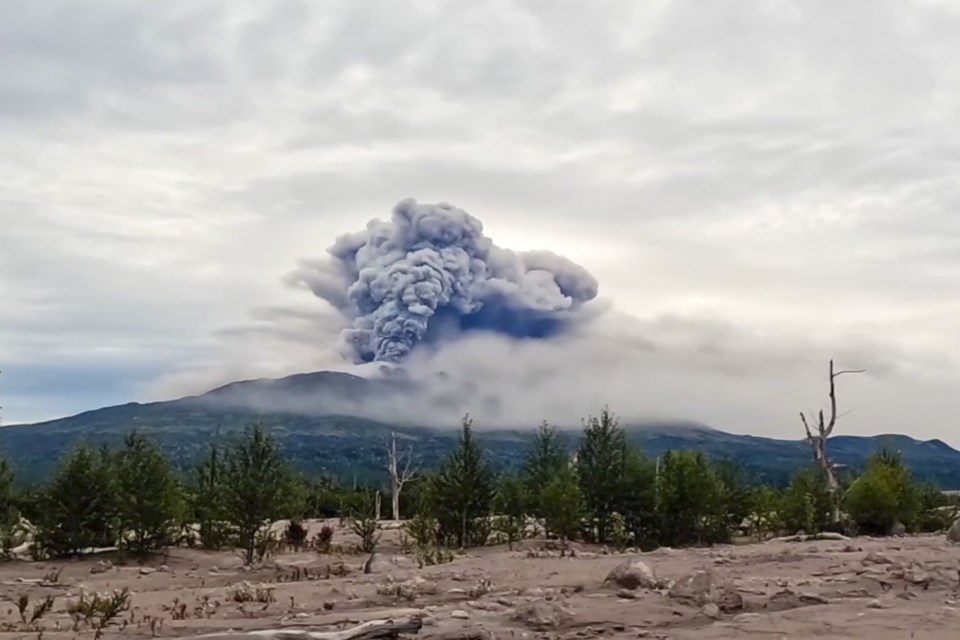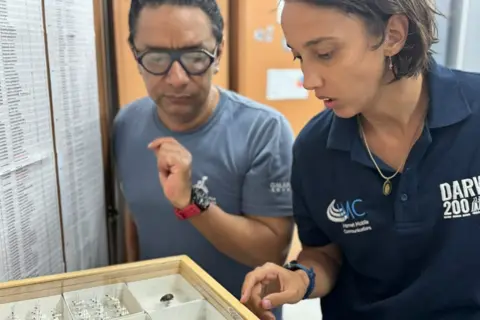KAMCHATKA
Volcano erupts after powerful earthquake in Russia's Far East and scientists warn of a stronger one

PETROPAVOVSK-KAMCHATSKY, Russia (AP) — One of Russia’s most active volcanoes has erupted, spewing plumes of ash 5 kilometers (3 miles) into the sky over the far eastern Kamchatka Peninsula and briefly triggering a “code red” warning for aircraft.
The Shiveluch volcano began sputtering shortly after a powerful 7.0 magnitude earthquake struck off Kamchatka’s east coast early Sunday, according to volcanologists from the Russian Academy of Sciences. They warned that another, even more potent earthquake may be on the way.
The academy’s Institute of Volcanology and Seismology released a video showing the ash cloud over Shiveluch. It stretched over 490 kilometers (304 miles) east and southeast of the volcano.
The Ebeko volcano located on the Kuril Islands also spewed ash 2.5 kilometers (1.5 miles) high, the institute said. It did not explicitly say whether the earthquake touched off the eruptions.
A “code red” ash cloud warning briefly put all aircraft in the area on alert, the Kamchatka Volcanic Eruption Response Team reported. A separate report on Sunday carried by the official Tass news agency said that no commercial flights had been disrupted and there was no damage to aviation infrastructure.
The tremors in the area may be a prelude to an even stronger earthquake in southeastern Kamchatka, Russian scientists warned. The Institute of Volcanology said a potential second quake could come “within 24 hours” with a magnitude approaching 9.0.
There were no immediate reports of injuries from Sunday’s earthquake, which struck at a depth of 6 kilometers (3.7 miles) under the sea bed with the epicenter 108 kilometers (67 miles) southeast of the nearest city, according to Russian emergency officials.
Russian news outlets cited residents of Petropavlovsk-Kamchatsky, a port city of more than 181,000 people that sits across a bay from an important Russian submarine base, reporting some of the strongest shaking “in a long time.”
On Nov. 4, 1952, a magnitude 9.0 quake in Kamchatka caused damage but no reported deaths despite setting off 9.1-meter (30-foot) waves in Hawaii.
The Associated Press
Russia's Shiveluch volcano erupts after 7.2 magnitude earthquake jolts Kamchatka region
Story by India Today

Russia's Shiveluch volcano erupts after 7.2 magnitude earthquake jolts Kamchatka region
After a 7.2 magnitude earthquake hit Russia's eastern Kamchatka region, the Shiveluch volcano erupted sending an ash column up to 8 kilometres high with a gush of lava, CNN reported, citing state-run media agency TASS.
According to media reports, no casualties or injuries were reported.
The 7.2-magnitude earthquake jolted the country's east coast at a depth of 51 km (32 miles), according to the European Mediterranean Seismological Centre (EMSC).
The US National Tsunami Warning Centre had reported a tsunami threat after the quake, however the emergency ministry of Russia's Kamchatka branch reported no tsunami threat.
Meanwhile, officials informed that the recorded aftershocks from the quake ranged in magnitude from 3.9 to 5.0.
According to the US Geological Survey, the earthquake struck 29 kilometres below the surface with its epicentre approximately 102 kilometres east of Petropavlovsk-Kamchatsky, which is surrounded by volcanoes and located across a bay from a key Russian submarine base.
The Shiveluch volcano is a colossal, perpetually active volcano and is renowned as one of the world's largest and most volatile volcanoes.
Russian news agency reported that there was no “major damage” in the quake and “buildings are now being examined for potential damage, with special attention paid to social facilities”.
Powerful earthquake hits off far east coast of Russia as nearby volcano erupts | Watch (msn.com)
By Reuters
Aug 17 (Reuters) - A magnitude 7.2 earthquake struck off the east coast of Russia's Kamchatka region at a depth of 51 km (32 miles), the European Mediterranean Seismological Centre (EMSC) said on Saturday.
The U.S. National Tsunami Warning Center said there was a tsunami threat from the quake.
But the Kamchatka branch of Russia's emergency ministry reported that there was no threat of tsunami and that the recorded aftershocks from the quake ranged in their magnitude from 3.9 to 5.0.
"Most of the aftershocks are imperceptible," the regional emergency authority said on Telegram.
Reporting by Maria Ponnezhath in Bengaluru; Additional reporting by Lidia Kelly in Melbourne; Editing by Andrew Cawthorne and Cynthia Osterman

























